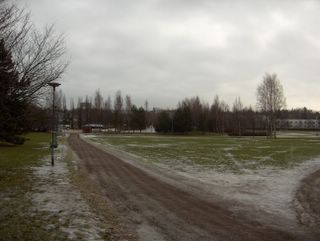
Kuvassa nähdään aikaisemman säätyypin vaihtuneen lauhaksi suojasääksi, joka alkoi 10.1. Ajoittain voimakkaat länsi- ja lounaistuulet toivat myös hieman sateita, jotka tulivat lähes kokonaan vetenä ko. päivinä. Niinpä lumipeite suli lähes kokonaan kuvauspäivään mennessä. Jäljellä oli vain jäisiä laikkuja. Maa oli kuitenkin yhä edelleen useita senttejä jäässä aikaisemmista pakkasista johtuen. Kuvassa vallitsivat sumu- ja kumpukerrospilvet, jotka ovat tyypillisiä näille lauhoille ilmavirtauksille Suomen talvessa. Kuvauspäivänä lämpötila oli ylimmillään +2,3 astetta, mutta oli yöllä tilapäisesti pakkasella (-4,4 astetta) pilvipeitteen oltua vähäinen ja tuulen heikkoa. Keskitalvella myös tuuli säätelee usein keskipäivänkin lämpötilan vaihteluita yön tapaan vähäisen auringonsäteilyn takia; mitä tuulisempaa, niin sitä lauhempaa. Riippuen kuitenkin niiden tuulten kulloinkin tuomasta ilmamassasta; lämpötila voi myös laskea rajusti yöstä keskipäivään mennessä tai lauhtua illan mittaan. Lämpötilan vuorokausivaihtelua ei joka tapauksessa ole usein olemassa loka - helmikuussa, kun se peittyy em. säänvaihteluiden alle edellisen kuvan yhteydessä kerrotusta syystä. Säätilanne: valitse 13.1.2006; Wetter3 A. Wetter3 B.
In the picture we see the change of weather type to a mild thaw, which started at 10th of january. Occasionally strong west and southwesterly winds brought also a little precipitation, which came allmost entirely in the form of rain during those days. Therefore allmost all of the snowcover melted away until the shooting day of the photo. Only icy patches were left. However the soil was still frozen several centimetres deep due to the previous frosts. In the picture the dominating clouds were stratus and stratocumulus clouds, which are typical of these mild airflows during winter in Finland. During the photoshooting day the temperature was +2,3 C at highest, but it was temporarily freezing (-4,4 C) at night due to clearer skies and weaker winds. In midwinter the winds also rule the changes in temperature at noon like at night, because of the minimal amount of the radiation of the sun; the more windy it is the milder it gets. Depending though of the quality of every air mass brought by those winds; it can get dramatically colder as well from night to noon or get milder during the evening. Therefore in any case the cycle of night and daytime temperature doesn't often exist during october - february due to the weather changes and due to the reason as mentioned in the previous picture. Weather condition: choose 13.1.2006; Wetter3 A. Wetter3 B.
Helsingin Puistolan säätilasto tammikuussa 2006 - Weather chart of Puistola, Helsinki in January 2006.
Flickr 1 Flickr 2



0 Comments:
Post a Comment
<< Home